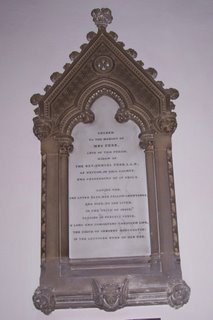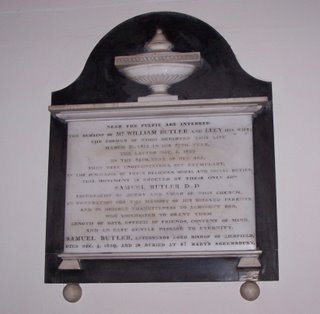 Inside the church of St. Nicholas, Kenilworth, there are two funerary monuments which may be of at least passing interest to a student of the classics. The first of these is this monument to Mrs. Parr, “late of this parish, widow of the Rev. Samuel Parr, LL.D., of Hatton in this county and prebendary of St. Paul’s.” Samuel Parr (1747-1825) was educated at Harrow and Emmanuel College, Cambridge, and returned to Harrow in 1767 as assistant head. When the headmaster died in 1771, Parr was passed over for the position, and in protest left Harrow to start his own school at Stanmore. In 1775, Dr. Parr and his students at Stanmore staged a production of Sophocles’ Oedipus Tyrannus. The student who took the role of Oedipus, Joseph Gerrald, later became a noted political reformer whose dissident activities earned him transportation to Australia and an early death. A production of Sophocles’ Trachiniae followed in 1776. Unfortunately, the Stanmore school failed to remain solvent, and Dr. Parr moved on to positions in Colchester and Norwich, before settling down as “perpetual curate” in the small village of Hatton, two miles west of Warwick.
Inside the church of St. Nicholas, Kenilworth, there are two funerary monuments which may be of at least passing interest to a student of the classics. The first of these is this monument to Mrs. Parr, “late of this parish, widow of the Rev. Samuel Parr, LL.D., of Hatton in this county and prebendary of St. Paul’s.” Samuel Parr (1747-1825) was educated at Harrow and Emmanuel College, Cambridge, and returned to Harrow in 1767 as assistant head. When the headmaster died in 1771, Parr was passed over for the position, and in protest left Harrow to start his own school at Stanmore. In 1775, Dr. Parr and his students at Stanmore staged a production of Sophocles’ Oedipus Tyrannus. The student who took the role of Oedipus, Joseph Gerrald, later became a noted political reformer whose dissident activities earned him transportation to Australia and an early death. A production of Sophocles’ Trachiniae followed in 1776. Unfortunately, the Stanmore school failed to remain solvent, and Dr. Parr moved on to positions in Colchester and Norwich, before settling down as “perpetual curate” in the small village of Hatton, two miles west of Warwick. “Men love to distinguish themselves,” Miss Crawford observes to Edmund Bertram in Jane Austen’s Mansfield Park. But a man can never distinguish himself as a clergyman. “A clergyman,” Miss Crawford asserts, “is nothing.” Rev. Dr. Samuel Parr, LL.D., of Hatton, would not have agreed. He had distinguished himself as a pipe smoker and a drinker of port, and as the schoolmaster who had first discovered the talents of Richard Brinsley Sheridan. He had distinguished himself also as a writer of Latin epitaphs—an arcane skill he exercised in providing inscriptions for the tombs of Burke, Fox, Gibbon, and Dr. Johnson. (His wife's plain English inscription doesn't even record her first name.) To those who knew him personally, he had distinguished himself as a conversationalist; to those who knew him only from his writings, he had distinguished himself as a pedantic and sesquipedalian stylist, excessively fond of footnotes that sank to the bottom of the page under the weight of classical quotations.
“Men love to distinguish themselves,” Miss Crawford observes to Edmund Bertram in Jane Austen’s Mansfield Park. But a man can never distinguish himself as a clergyman. “A clergyman,” Miss Crawford asserts, “is nothing.” Rev. Dr. Samuel Parr, LL.D., of Hatton, would not have agreed. He had distinguished himself as a pipe smoker and a drinker of port, and as the schoolmaster who had first discovered the talents of Richard Brinsley Sheridan. He had distinguished himself also as a writer of Latin epitaphs—an arcane skill he exercised in providing inscriptions for the tombs of Burke, Fox, Gibbon, and Dr. Johnson. (His wife's plain English inscription doesn't even record her first name.) To those who knew him personally, he had distinguished himself as a conversationalist; to those who knew him only from his writings, he had distinguished himself as a pedantic and sesquipedalian stylist, excessively fond of footnotes that sank to the bottom of the page under the weight of classical quotations.In 1800, Dr. Parr distinguished himself as a controversialist, delivering a sermon which attacked William Godwin for his doctrine of “universal benevolence.” Godwin, in his Enquiry Concerning Political Justice, had argued that attachment to the public good should outweigh all personal attachments, such as the attachment between parent and child. Universal benevolence was the true basis of all moral action. To Dr. Parr, this was idealistic nonsense. Parr believed that all moral action arose out of particular attachments, not out of a theoretical benevolence toward all of humanity.
The review of Dr. Parr’s sermon in the Edinburgh Review begins parodically:
Whoever has had the good fortune to see Dr. Parr’s wig, must have observed, that while it trespasses a little on the orthodox magnitude of perukes in the anterior parts, it scorns even Episcopal limits behind, and swells out into boundless convexity of frizz, the mega fauna of barbers, and the terror of the literary world. After the manner of his wig, the Doctor has constructed his sermon, giving us a discourse of no common length, and subjoining an immeasurable mass of notes, which appear to concern every learned thing, every learned man, and almost every unlearned man since the beginning of the world.
The distinguished Dr. Parr was accustomed to such humor at his expense, and appeared to take it in stride, as perhaps all eccentrics must. On another occasion, he wrote: “By that countless and harmless swarm of scribblers who amuse themselves, and readers equally idle with themselves, by paragraphs upon my opinons in politics, my peculiarities in dress, or my love of ancient literature, I have too much firmness, and indeed, too much understanding, to be offended for one moment. My character, I am told, presents a wide front for attack to these puny assaults...”
At Hatton, Dr. Parr surrounded himself with books and students, composed Latin epitaphs, and cultivated his reputation for eccentricity. The classical scholar Richard Porson was a frequent guest at the vicarage. As curate, Dr. Parr tended to the “ignorant, dissolute, insolent, and ungrateful” poor of his parish, and privately complained that Warwickshire was “the Boeotia of England, two centuries behind in civilization.” On his arrival at Hatton, his first innovation was to require the bells to be rung for three times as long—and Dr. Parr himself took the lead in the ringing. In 1816, he told a correspondent:
You are right in supposing I am extremely fond of Bells, and you will not be wrong in assuming that neither in practice nor in theory I am quite a novice. To this hour I, with unusual dexterity, can set either a large or a small bell, so balanced, as not to require a stay, and I can ring in a round peal of six or eight, the treble, the fifth, and the tenor, and these three, you know, are the trying situations for the ringer, but my experience with eight bells goes only to round ringing, though my theoretical knowledge extends much farther in changes. When a schoolboy I was the first person known in the parish to raise, without aid, and to ring a tenor which weighed 23 cwt 3 qrs and 2 lbs, but I understood the compass, the hunt, dodging, snapping, and place-making, and I disliked what the College Youths call firing. We had only six bells, and I performed pretty well upon the grandsire six in the College single, the Oxford double Bob, the Court Bob, and the Treble Bob. This was the boundary of my practice in changes, but my speculations extend to Triples and ringing the observation or second Bell, on a peal of seven to the double Bob major, the Bob major reverse, the London Court Bob,the Norwich Court Bob, the Oxford Double Bob upon eight, and to the Bob of 5,120 with a produce of fifteen courses on tenor twelve, to the London Court Bob upon ten, and even to the Oxford treble Bob maximus upon twelve.
On the effect of a peal of bells on Dr. Parr, one acquaintance wrote: “His hard pedantry softened under its melody.”
 This second monument, in the south transept, is dedicated to William Butler and his wife Lucy, and was erected by their son, Samuel Butler, D.D. Samuel Butler (1774-1839) was born in Kenilworth and had a distinguished academic career at Rugby and at St. John’s College, Cambridge, where he received numerous prizes for Latin and Greek composition. (His chief competition for prizes in the composition of Greek poetry was Samuel Taylor Coleridge.) He took his B.A. in 1796, was made a fellow of St. John’s, and went on to have a long and distinguished career as the headmaster of the Shrewsbury school. He also had a distinguished career in the church, beginning as the vicar of St. Nicholas, Kenilworth (1802), and ending as the Archbishop of Lichfield (1836). He also published a four-volume edition of the works of Aeschylus (1809-1816) and a popular school geography textbook. And it was Dr. Samuel Butler delivered the funeral sermon for Dr. Samuel Parr. A Life of Samuel Butler was written by his grandson, also named Samuel Butler, who is known to classicists as the author of The Authoress of the Odyssey, and to a somewhat wider public as the author of The Way of All Flesh and Erehwon.
This second monument, in the south transept, is dedicated to William Butler and his wife Lucy, and was erected by their son, Samuel Butler, D.D. Samuel Butler (1774-1839) was born in Kenilworth and had a distinguished academic career at Rugby and at St. John’s College, Cambridge, where he received numerous prizes for Latin and Greek composition. (His chief competition for prizes in the composition of Greek poetry was Samuel Taylor Coleridge.) He took his B.A. in 1796, was made a fellow of St. John’s, and went on to have a long and distinguished career as the headmaster of the Shrewsbury school. He also had a distinguished career in the church, beginning as the vicar of St. Nicholas, Kenilworth (1802), and ending as the Archbishop of Lichfield (1836). He also published a four-volume edition of the works of Aeschylus (1809-1816) and a popular school geography textbook. And it was Dr. Samuel Butler delivered the funeral sermon for Dr. Samuel Parr. A Life of Samuel Butler was written by his grandson, also named Samuel Butler, who is known to classicists as the author of The Authoress of the Odyssey, and to a somewhat wider public as the author of The Way of All Flesh and Erehwon.


No comments:
Post a Comment